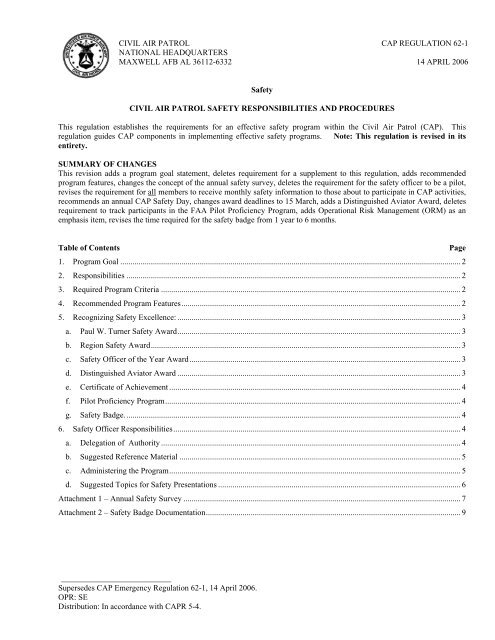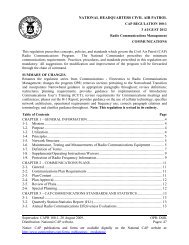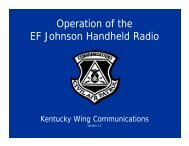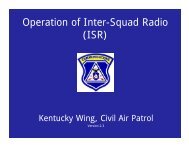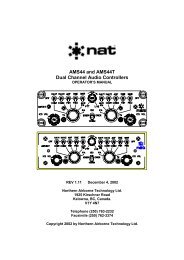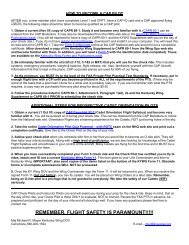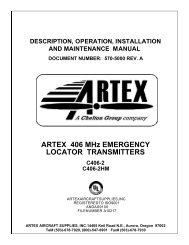Safety (62-1) - Kentucky Wing CAP
Safety (62-1) - Kentucky Wing CAP
Safety (62-1) - Kentucky Wing CAP
You also want an ePaper? Increase the reach of your titles
YUMPU automatically turns print PDFs into web optimized ePapers that Google loves.
CIVIL AIR PATROL <strong>CAP</strong> REGULATION <strong>62</strong>-1<br />
NATIONAL HEADQUARTERS<br />
MAXWELL AFB AL 36112-6332 14 APRIL 2006<br />
<strong>Safety</strong><br />
CIVIL AIR PATROL SAFETY RESPONSIBILITIES AND PROCEDURES<br />
This regulation establishes the requirements for an effective safety program within the Civil Air Patrol (<strong>CAP</strong>). This<br />
regulation guides <strong>CAP</strong> components in implementing effective safety programs. Note: This regulation is revised in its<br />
entirety.<br />
SUMMARY OF CHANGES<br />
This revision adds a program goal statement, deletes requirement for a supplement to this regulation, adds recommended<br />
program features, changes the concept of the annual safety survey, deletes the requirement for the safety officer to be a pilot,<br />
revises the requirement for all members to receive monthly safety information to those about to participate in <strong>CAP</strong> activities,<br />
recommends an annual <strong>CAP</strong> <strong>Safety</strong> Day, changes award deadlines to 15 March, adds a Distinguished Aviator Award, deletes<br />
requirement to track participants in the FAA Pilot Proficiency Program, adds Operational Risk Management (ORM) as an<br />
emphasis item, revises the time required for the safety badge from 1 year to 6 months.<br />
Table of Contents<br />
Page<br />
1. Program Goal ....................................................................................................................................................................... 2<br />
2. Responsibilities .................................................................................................................................................................... 2<br />
3. Required Program Criteria ................................................................................................................................................... 2<br />
4. Recommended Program Features......................................................................................................................................... 2<br />
5. Recognizing <strong>Safety</strong> Excellence: ........................................................................................................................................... 3<br />
a. Paul W. Turner <strong>Safety</strong> Award........................................................................................................................................... 3<br />
b. Region <strong>Safety</strong> Award........................................................................................................................................................ 3<br />
c. <strong>Safety</strong> Officer of the Year Award..................................................................................................................................... 3<br />
d. Distinguished Aviator Award ........................................................................................................................................... 3<br />
e. Certificate of Achievement ............................................................................................................................................... 4<br />
f. Pilot Proficiency Program................................................................................................................................................. 4<br />
g. <strong>Safety</strong> Badge..................................................................................................................................................................... 4<br />
6. <strong>Safety</strong> Officer Responsibilities............................................................................................................................................. 4<br />
a. Delegation of Authority ................................................................................................................................................... 4<br />
b. Suggested Reference Material .......................................................................................................................................... 5<br />
c. Administering the Program............................................................................................................................................... 5<br />
d. Suggested Topics for <strong>Safety</strong> Presentations ....................................................................................................................... 6<br />
Attachment 1 – Annual <strong>Safety</strong> Survey ........................................................................................................................................ 7<br />
Attachment 2 – <strong>Safety</strong> Badge Documentation............................................................................................................................. 9<br />
___________________________<br />
Supersedes <strong>CAP</strong> Emergency Regulation <strong>62</strong>-1, 14 April 2006.<br />
OPR: SE<br />
Distribution: In accordance with <strong>CAP</strong>R 5-4.
2 <strong>CAP</strong>R <strong>62</strong>-1 14 APRIL 2006<br />
1. Program Goal. The underlying goal of the <strong>CAP</strong> <strong>Safety</strong> Program is to minimize the risks faced by our membership in<br />
the performance of their volunteer duties.<br />
2. Responsibilities:<br />
a. All levels of command shall work in partnership to develop effective safety education and accident prevention<br />
measures to safeguard our members and preserve our physical resources.<br />
b. All levels of command shall seek to instill a culture of safety that guides the planning and execution of every <strong>CAP</strong><br />
activity.<br />
c. Individual members will live the <strong>CAP</strong> motto of “Always Vigilant” in planning, conducting, and participating in all<br />
<strong>CAP</strong> activities. Hazards and potentially unsafe behavior will be addressed immediately and then reported to higher authority.<br />
d. Commanders at all levels carry the responsibility of taking immediate action against any <strong>CAP</strong> member who places a<br />
fellow member at unnecessary risk. Punitive measures may range from counseling to the loss of membership.<br />
e. The effectiveness of each commander’s safety efforts shall be evaluated yearly through the Annual <strong>Safety</strong> Survey<br />
(Attachment 1) process. The safety officer and commander at the next higher echelon will review and comment on the<br />
surveys of all their subordinate units.<br />
3. Required Program Criteria:<br />
a. Each level of command shall formally appoint a safety officer with qualifications appropriate to the local risk<br />
environment. Members in command positions should not serve as safety officer. Whenever possible, and especially in flying<br />
units, members with flying experience should be selected.<br />
b. Within 90 days of appointment, each safety officer shall complete the AFIADL Course 02170, entitled “<strong>CAP</strong> <strong>Safety</strong><br />
Officer” or equivalent training.<br />
c. Each safety officer shall complete an independent comprehensive internal safety survey at least annually. Items to<br />
be addressed in this survey shall include, but are not limited to, those listed in attachment 1. This report shall be sent directly<br />
to the safety officer and the commander at the next higher echelon.<br />
d. <strong>Safety</strong> Officers shall develop a program of regular safety education and accident prevention training for the unit(s)<br />
to which they are assigned. This program shall deliver no less than 15 minutes per month (or 3 hours per year) of face-toface<br />
education and training to the membership. At least once annually, Operational Risk Management (ORM) will be<br />
discussed. New members will receive ORM familiarization training. Current members will receive an ORM review.<br />
Sample briefings and educational material can be downloaded from the ORM link at<br />
http://level2.cap.gov/index.cfm?nodeID=5182. Rational flexibility should be used to get the latest safety meeting<br />
information to members before they participate in a <strong>CAP</strong> activity. Any system that gets the message to the member is<br />
acceptable – e-mail with read receipt, videotaping the presentation for later playback, audio taping, read file or any other<br />
method that works. Emphasize active members participating in <strong>CAP</strong> activities and document efforts. Brief reports of topics<br />
covered and total members attending shall be forwarded to the next higher echelon of command. These reports shall be<br />
factored into the annual program assessment (<strong>Safety</strong> Survey).<br />
e. <strong>Safety</strong> briefings shall be incorporated into all field training exercises, encampments, and other special activities<br />
where members face risk.<br />
f. The Civil Air Patrol <strong>Safety</strong> Improvement or Hazard Report, <strong>CAP</strong>F 26, and/or FAA Form 8740-5, <strong>Safety</strong><br />
Improvement Report, shall be used to suggest ways to reduce operational risk to members.<br />
g. All mishaps will be promptly reported and investigated in accordance with <strong>CAP</strong>R <strong>62</strong>-2, Mishap Reporting and<br />
Investigation. Special attention will be given to any contributing factors that can be promptly corrected.<br />
h. An annual <strong>Safety</strong> Day will be held in all units sometime during the month of October to focus on improving safety<br />
knowledge and attitudes during the new fiscal year.<br />
4. Recommended Program Features:<br />
a. Review of safety newsletters published by the Civil Air Patrol and other safety oriented organizations.
<strong>CAP</strong>R <strong>62</strong>-1 14 APRIL 2006 3<br />
b. Placement of a bulletin board devoted to safety issues.<br />
c. Participation or partnership in activities sponsored by other safety oriented organizations.<br />
d. Use of special safety seminars, discussions, or focus groups to address specific issues.<br />
e. Participation by pilots in the FAA’s Pilot Proficiency Program (“<strong>Wing</strong>s Program”).<br />
f. Adding safety messages to other routine communications.<br />
g. Use of the optional safety award program authorized in this directive.<br />
5. Recognizing <strong>Safety</strong> Excellence:<br />
a. Paul W. Turner <strong>Safety</strong> Award - An annual award presented to the <strong>CAP</strong> wing with the most outstanding safety<br />
program and safety record. The award consists of a plaque and includes the wing's name being placed on the <strong>CAP</strong> safety<br />
scroll at National Headquarters. Each region commander may submit one nomination for the previous year to NHQ <strong>CAP</strong>/SE,<br />
which must be postmarked not later than 15 March. The award will be presented to the wing commander at the annual<br />
National Conference. Nominations that are late or that have not been coordinated through the region commander will not be<br />
considered for the award.<br />
(1) The region commander's letter of nomination should include, but not be limited to, the following:<br />
(a) <strong>Safety</strong> program and its implementation.<br />
(b) Public Affairs (PA) support of the safety program.<br />
(c) <strong>Safety</strong> officer manning.<br />
(d) Hazards faced by the wing that were successfully mitigated.<br />
(e) Outstanding facts.<br />
(f) Comments on mission accomplishment.<br />
(2) Also considered will be other information available at National Headquarters, such as:<br />
(a) Aircraft utilization rates.<br />
(b) Aircraft condition and quality of maintenance.<br />
(c) Number of reportable aircraft accidents.<br />
(d) Number of vehicle accidents.<br />
(e) Personnel injuries.<br />
(f) Adequacy of accident reports.<br />
b. Region <strong>Safety</strong> Award - A plaque presented annually to one wing from each region. This selection is made by the<br />
region commander and is based on the same criteria as the Paul W. Turner Award. <strong>Wing</strong>s nominated for the Paul W. Turner<br />
Award automatically receive the region award. Presentation will be made by the region commander at an appropriate<br />
function.<br />
c. <strong>Safety</strong> Officer of the Year Award - An annual award presented to the safety officer who has contributed most to<br />
the <strong>CAP</strong> safety program. Each wing may submit a nomination to region. The region commander will review all nominations<br />
submitted and will select one nominee believed to be the most deserving of the award. The region commander will forward<br />
the nomination to NHQ <strong>CAP</strong>/SE for final selection. All nominations must be forwarded by the region to National<br />
Headquarters postmarked not later than 15 March. Nominations that are late or that have not been coordinated through the<br />
region commander win not be considered for the award.<br />
d. Distinguished Aviator Award - This award recognizes outstanding airmanship by a <strong>CAP</strong> pilot. The pilot must<br />
demonstrate heroic measures or an extraordinary level of skill, alertness, ingenuity, or proficiency in averting or minimizing<br />
the seriousness of a flight mishap. NHQ <strong>CAP</strong>/SE will convene an Awards Board to review the nomination and evaluate the<br />
seriousness of the incident as well as the nominee's action in coping with the situation.<br />
(1) The emergency must have resulted from any of these situations:<br />
(a) Mechanical difficulty with the aircraft while in flight or on the ground.
4 <strong>CAP</strong>R <strong>62</strong>-1 14 APRIL 2006<br />
(b) Errors made by others, in the air or on the ground.<br />
(c) Environmental factors beyond the nominee's control.<br />
Note: Members who prevented a potential mishap that they caused by their own misdeeds, lack of judgment, or<br />
foolhardy/excessive risk-taking are ineligible.<br />
(2) Nominations must be initiated by the unit commander following the emergency. Nomination packages will<br />
then be forwarded and endorsed through the chain of command to NHQ <strong>CAP</strong>/SE for review by the Awards Board. The<br />
nomination must include as a minimum:<br />
(a) The nominee's name.<br />
(b) Rank.<br />
(c) Unit name and charter number.<br />
(d Date of the event.<br />
(e) Aircraft type and N-number.<br />
(f) A description of the event, detailed enough to allow the Awards Board to accurately evaluate the<br />
seriousness of the event and determine the extent of the nominees corrective action.<br />
(3) The award will be sent to the respective region commander for presentation at an appropriate function.<br />
e. Certificate of Achievement - A certificate presented annually to <strong>CAP</strong> units that have operated without a mishap for<br />
1-calendar year. <strong>Wing</strong> commanders will submit a list of units by name and charter number eligible for this award to NHQ<br />
<strong>CAP</strong>/SE not later than 15 March each year. This list will be verified with existing headquarters safety records. Presentation<br />
will be made at an appropriate time determined by the wing commander.<br />
f. Pilot Proficiency Program - <strong>Wing</strong> safety officers will encourage pilot members to participate in the FAA Pilot<br />
Proficiency Program. Members who complete the first phase of this program will be eligible to wear the PPP patch on flight<br />
clothing.<br />
g. <strong>Safety</strong> Badge - A safety badge has been approved for wear with the Civil Air Patrol uniform. To qualify for the<br />
basic <strong>Safety</strong> Badge, the member must complete and document (attachment 2) the specialty track requirements for the<br />
Technician Rating as described in <strong>CAP</strong>P 217. The Senior <strong>Safety</strong> Badge requires completion of the Senior Rating and the<br />
Master <strong>Safety</strong> Badge requires completion of the Master Rating.<br />
6. <strong>Safety</strong> Officer Responsibilities:<br />
a. Delegation of authority is essential in any well-managed organization, but the command responsibility for a safety<br />
program cannot be delegated. Therefore, staff safety officer positions have been established to assist and advise<br />
commanders. <strong>CAP</strong>M 20-1, Organization of <strong>CAP</strong>, outlines the responsibilities of the safety officer in assisting and advising<br />
the commander in the management of the overall <strong>CAP</strong> <strong>Safety</strong> Program. These responsibilities include:<br />
(1) Performing safety surveys both annually and at other times when hazards or hazardous operations so warrant.<br />
(2) Directing accident investigations and preparing mishap reports.<br />
(3) Planning safety training programs to include guest speakers to acquaint all personnel with their responsibility<br />
for applying safe practices.<br />
(4) Conducting staff visits to subordinate units to assist them in identifying and solving safety problems.<br />
(5) Maintaining a roster of subordinate unit safety officers.<br />
(6) Reviewing and analyzing findings of accident reports to determine trends and methods for preventing future<br />
accidents.<br />
(7) Developing training guides and arranging for publicity of safety programs through such media as bulletin<br />
boards, newsletters, websites, press releases, etc.<br />
(8) Establishing a safety hazard reporting program.
<strong>CAP</strong>R <strong>62</strong>-1 14 APRIL 2006 5<br />
(9) Performing safety reporting as required by the region director of safety.<br />
(10) Ensuring unit compliance with this regulation and <strong>CAP</strong>R <strong>62</strong>-2.<br />
b. Suggested Reference Material:<br />
(1) Publications:<br />
(a) <strong>CAP</strong> Regulations 60-1, <strong>62</strong>-1, <strong>62</strong>-2, 66-1, 76-1, and 77-1.<br />
(b) Title 49, Transportation, Chapter VIII, National Transportation <strong>Safety</strong> Board (NTSB), Part 830,<br />
Notification and reporting of Aircraft Accidents, Incidents, and Overdue Aircraft.<br />
(c) State Driver's Handbook.<br />
(d) Supplemental safety directives established by higher headquarters.<br />
(e) FAA Advisory Circulars.<br />
(f) Federal Aviation Regulations and Aeronautical Information Manual (FAR/AIM).<br />
(g) Monthly <strong>Safety</strong> Newsletters.<br />
(2) Forms:<br />
(a) <strong>CAP</strong>F 78, <strong>CAP</strong> Mishap Report Form.<br />
(b) <strong>CAP</strong>F 79, <strong>CAP</strong> Accident Investigation Form.<br />
(c) Pertinent <strong>CAP</strong> wing forms, safety reports, inspection reports, etc.<br />
(d) <strong>CAP</strong>F 26, <strong>CAP</strong> <strong>Safety</strong> Improvement or Hazard Report.<br />
(e) FAA Form 8740-5, FAA <strong>Safety</strong> Improvement Report.<br />
c. Administering the Program:<br />
(1) Establish a schedule of events. This schedule should include safety inspections and surveys, safety<br />
presentations, staff visits, and publicity of seasonal safety hazard items, i.e. thunderstorms, snow/ice, heatstroke, etc.<br />
(2) Complete the <strong>Safety</strong> Survey (Attachment 1) at least annually. When surveys are completed, they should be<br />
sent to the next higher echelon for review, comments, and signatures.<br />
(3) Local procedures should be established on accident reporting procedures. This information should include who<br />
is notified, how notified, time limits requirements for processing <strong>CAP</strong>F 78, who will investigate accidents, and requirements<br />
for processing <strong>CAP</strong>F 79. (See <strong>CAP</strong>R .<strong>62</strong>-2)<br />
(4) Establish a safety meeting file. This file should contain safety lecture outlines for topics to be covered in safety<br />
presentations plus a list of safety meeting resources, i.e. nearby military safety personnel, safety websites for different topics,<br />
videos, guest speakers, subject matter experts, etc. Summaries of safety meeting topics and attendance records should also be<br />
kept in this file. Commanders are urged to use “rational flexibility” in getting safety information to people that don’t attend<br />
safety meetings. Use any effective means to get the information to your people; especially before they participate in a <strong>CAP</strong><br />
activity.<br />
(5) Establish a file of safety educational material. This may include safety guides, magazine articles, FAA<br />
Advisory Circulars, posters, articles for bulletin boards, newspaper clippings, the monthly safety bulletins, or a list of safetyrelated<br />
websites.<br />
(6) Place an emphasis on Operational Risk Management (ORM). Make risk management a part of every activity.<br />
The above guidelines are provided to give safety officer a starting point for establishing a viable program within their unit. It<br />
is not complete. Selling safety requires complete dedication and never-ending attention. The safety officers must be<br />
supported fully by the commander if the safety program is to be effective.
6 <strong>CAP</strong>R <strong>62</strong>-1 14 APRIL 2006<br />
d. Suggested Topics for <strong>Safety</strong> Presentations:<br />
FLIGHT<br />
Sterile Cockpit Procedures - How/when the aircrew will minimize extraneous conversations during critical phases of<br />
ground and flight operations.<br />
Aircraft Emergency Procedures - Complete engine failure, partial engine failure, electrical system failure, radio<br />
failures, lost procedures, hazardous weather, instrument failures, etc.<br />
Takeoff and Landing Techniques - Normal, variable flap, short/soft field, x-wind, gusty conditions; takeoff and<br />
landing characteristics of different <strong>CAP</strong> aircraft.<br />
Aircraft Performance - Power settings, fuel consumption, range airspeeds, useful load, weight and balance.<br />
Seasonal Flying:<br />
Winter- Cold weather procedures during conditions of frost, ice, and rain.<br />
Summer-How temperatures and density altitude affect aircraft performance, thunderstorms.<br />
Spring/Fall- Winds, visibility.<br />
Night Flying - Physical factors, lights, airports, etc.<br />
FAA and <strong>CAP</strong> Currency Requirements - Minimum requirements don’t necessarily guarantee proficiency in takeoffs,<br />
landings, and instruments for all pilots.<br />
Wake Turbulence - Where and how wake turbulence is generated.<br />
Aircraft Ground Handling and Servicing - (FAA Advisory Circular 00-34) Taxiing, fueling, proper grounding of<br />
aircraft during fueling.<br />
Aircraft Tie-Down - (FAA Advisory Circular 2-35B) - Procedures for proper tie-down of aircraft and the proper<br />
materials to use – (Also see <strong>CAP</strong>R 66-1)<br />
Medical Aspects of Aviation - Fatigue, alcohol, drugs.<br />
Ditching<br />
In-flight fires<br />
Mountain flying<br />
Use of Oxygen<br />
Scuba diving and flying<br />
Taxi Procedures - Are unprepared taxi areas surveyed for holes, soft areas, and depressions?<br />
Aircraft Inspection Requirements - FAA inspection requirements - 100 Hr, transponder, VOR, pitot static system,<br />
ELT, and annual.<br />
GROUND<br />
<strong>CAP</strong> Drivers License Requirement - (See <strong>CAP</strong>R 77-1).<br />
Defensive Driving - The hazards created by the other guy.<br />
Use of Seatbelts – Why it needs to be a habit.<br />
The Problem of Alcohol and Drugs - How they affect the individual: delayed reactions, thought process, etc. and the<br />
combined effects of drugs and alcohol.<br />
Hidden <strong>Safety</strong> Hazards of Home and Office - Flammables, slipping/tripping hazards, storage, etc.<br />
Water <strong>Safety</strong> - Swimming and boating hazards - Buddy system.<br />
Adjusting Speeds to Road Conditions - Fog, rain, obstruction to vision, or slippery roads.<br />
Inspection and Maintenance – How these can affect vehicle safety.<br />
Fire Prevention - Fire Prevention campaign (normally in October).<br />
This is by no means a complete list. All of the different ways that someone can be injured or hardware can be damaged has<br />
an associated lesson to be learned in the way of a safety message. Highlight as many of these risks to your people as you can.<br />
Discuss ways to control these risks and highlight the need to watch out for each other. <strong>CAP</strong> should be fun but, the fun stops<br />
when someone is injured.
<strong>CAP</strong>R <strong>62</strong>-1 ATTACHMENT 1 14 APRIL 2006 7<br />
Attachment 1 – Annual <strong>Safety</strong> Survey<br />
Unit Surveyed: ______________________________________<br />
Date of Survey: ______________________<br />
<strong>Safety</strong> Officer’s Name and Rank: _________________________________________________________________________<br />
<strong>Safety</strong> Officer’s Phone Number and E-mail: _________________________________________________________________<br />
Instructions: Complete this survey and submit it directly to the next higher level of command not later than 31 January of<br />
each year. Each item may be answered (Y) Yes, (N) No, or (U) Unable to Determine. Use the comments area to explain the<br />
answers. Once the survey is reviewed and signed by the next higher level safety officer and commander, with comments<br />
and/or directions on how deficiencies will be addressed, a copy will be returned to the surveyed unit. This step should be<br />
completed within 30 days.<br />
A. Have any members been injured during <strong>CAP</strong> activities sponsored by this unit?<br />
Answer: __________<br />
Comments:<br />
B. Have any unit vehicles, aircraft, or other assigned equipment been damaged during <strong>CAP</strong> activities?<br />
Answer: __________<br />
Comments:<br />
C. Have mishap reports been submitted in a timely manner and have investigations been thorough with effective<br />
corrective items?<br />
Answer: __________<br />
Comments:<br />
D. ORM -- Are hazards promptly identified, risks analyzed, and effective risk controls implemented in the facility<br />
and prior to <strong>CAP</strong> activities?<br />
Answer: __________<br />
Comments:<br />
E. Are aircraft, vehicles, and facilities equipped with appropriate first aid kits and serviceable fire extinguishers?<br />
Answer: __________<br />
Comments:
8 <strong>CAP</strong>R <strong>62</strong>-1 ATTACHMENT 1 (CONT’D) 14 APRIL 2006<br />
F. Are flight release procedures, aircraft inspection requirements, and operational checklists rigorously followed?<br />
Answer: __________<br />
Comments:<br />
G. Does the unit have individuals who put themselves or others at increased risk? If yes, has this issue been raised to<br />
the commander?<br />
Answer: __________<br />
Comments:<br />
H. Has the unit commander made efforts to ensure the safety of members and the preservation of <strong>CAP</strong> resources?<br />
Answer: __________<br />
Comments:<br />
Signature of the <strong>Safety</strong> Officer: _______________________________________________________________<br />
Comments by the Commander:<br />
____________________________________________<br />
Commander’s Name, Rank<br />
________________________________________<br />
Signature and Date<br />
---------------------------------------------------------------------------------------------------------------------------------------<br />
Comments by the Next Higher Echelon <strong>Safety</strong> Officer:<br />
____________________________________________<br />
<strong>Safety</strong> Officer’s Name, Rank<br />
________________________________________<br />
Signature and Date<br />
---------------------------------------------------------------------------------------------------------------------------------------<br />
Comments by the Next Higher Echelon Commander:<br />
____________________________________________<br />
Commander’s Name, Rank and Title<br />
________________________________________<br />
Signature and Date
<strong>CAP</strong>R <strong>62</strong>-1 ATTACHMENT 2 14 APRIL 2006 9<br />
Attachment 2 – <strong>Safety</strong> Badge Documentation<br />
1. Documentation required to be forwarded to the <strong>CAP</strong> Region <strong>Safety</strong> Officer with the application for the safety badge:<br />
a. A copy of the safety officer’s letter of appointment.<br />
b. A copy of the <strong>Safety</strong> Officer Course Completion Certificate.<br />
2. After completion of Air Force Institute for Advanced Distributed Learning (AFIADL) Course 02170, Civil Air Patrol<br />
<strong>Safety</strong> Officer Course, individuals should forward a copy of the AFIADL Certification of Course Completion to National<br />
Headquarters/SE. Upon receipt, a <strong>CAP</strong>C 49 "<strong>CAP</strong> <strong>Safety</strong> Officers Course" certificate will be completed and returned to the<br />
wing for presentation.<br />
3. All of the following items will be completed as indicated and certified by the unit commander:<br />
REQUIREMENT DATE COMPLETED CERTIFIED BY UNIT COMMANDER<br />
<strong>Safety</strong> Officer Course<br />
Unit flight clinic or safety seminar<br />
Ground safety meeting (non-flying units)<br />
<strong>Safety</strong> meeting<br />
<strong>Safety</strong> meeting<br />
<strong>Safety</strong> meeting<br />
<strong>Safety</strong> meeting<br />
<strong>Safety</strong> meeting<br />
<strong>Safety</strong> meeting<br />
Serve as <strong>Safety</strong> Officer for 6 months<br />
This attachment may be locally reproduced and used as a checklist by the member as requirements are completed. After all<br />
criteria are met, a copy of the completed attachment will be forwarded to the Region <strong>Safety</strong> Officer for review and approval<br />
for the award of the safety badge.


